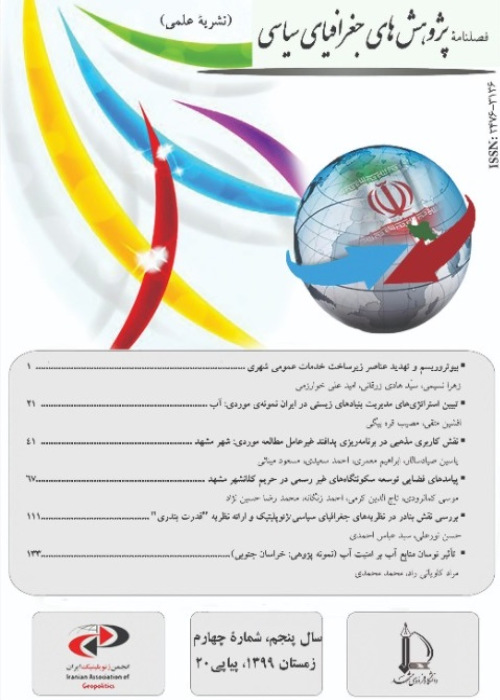The Impact of Nile Hydropolitics on Geopolitical Relations between Egypt, Sudan, and Ethiopia: With a Focus on the Renaissance Dam
The Nile plays a key role in the economies of Egypt, Sudan, and Ethiopia, and is a major driver of competition between them. Despite the competition between the three countries, they had no challenge until the early 1990s. But since then, as a result of increasing demand, the competition for the Nile water rights increased as a result of the Ethiopian government's move to build the Renaissance Dam in 2011. This descriptive-analytical study explores the impact of the Nile hydropolitics on geopolitical relations between Egypt, Sudan, and Ethiopia. The findings of this study indicate that colonial conventions, the lack of a proper mechanism for water division, population growth, agricultural and industrial development in the Nile Basin, the construction of the Renaissance Dam in Ethiopia, and finally the involvement of foreign powers have caused the Nile Basin became an area of hydropolitical competition between the beneficiary countries. Consequently, due to the insistence of the upstream countries on the fair share of the Nile water, the Nile Hydropolicy will create the “geopolitical confrontation” among the three countries.
No country can maintain its political, economic and social stability without having sufficient water. Due to population growth and the development of industries, freshwater resources and access to them has become a "geopolitical crisis" in some countries. A striking example is a dispute between the three states of Ethiopia, Sudan, and Egypt over the water right from the Nile River. Although there are about eleven countries, locating along the Nile River route and each complaining about its share of water, the largest disagreement on how to exploit the Nile is among the mentioned three countries as they do not use the same amount of water from the Nile. The highest level of water from the Nile is consumed by Egypt and Sudan. In recent years, issues such as population growth and the urgent need for water for domestic and agricultural use have led Ethiopia to demand a fair share of the Nile water. Therefore, in 2011, Ethiopia started constructing the Renaissance Dam, which will have negative consequences for the downstream countries.
This theoretical study employs a descriptive-analytical method. The data are collected using a library technique from different books, articles, first-hand references, and valid internet resources. The study explores the impact of the Nile hydropolitics on geopolitical relations between Egypt, Sudan, and Ethiopia. Accordingly, it is hypothesized that the Nile has placed Egypt, Sudan, and Ethiopia on the verge of a geopolitical confrontation.
Heterogeneous rainfall distribution contributes to the irregular distribution of freshwater worldwide, with 40 percent of the world’s land mass being located in North Africa, Australia, and the Middle East, which holds only 2 percent of the world's freshwater resources. The war on water is one of the most repetitive events in history, and the likelihood of it happening again in the future has increased. A striking example is the dispute between Egypt, Sudan, and Ethiopia over the exploitation of the Nile and the construction of dams on it. The need for water for consumption and agriculture led to the conclusion of the agreement on the exploitation of the Nile between Britain and Italy in 1920, whereby about 48 billion cubic meters of water entered Egypt annually and about 4 billion cubic meters were Sudan's share. The proposal to build a major dam in Aswan revealed the necessity of revising the 1929 agreement. As a result, another agreement was signed for the full exploitation of the Nile water, whereby Egypt received 55 billion m3 of water annually, while Sudan received a share of 18.5 billion m3. After many years of exploiting Egypt, the Britain turned to Sudan and Ethiopia in the upper part of the Nile in order to produce more cotton and wheat. Dam construction on the Nile continued nonstop, but peaked in the 1960s, with a greater number of dams built on the Nile by Sudan and Ethiopia. Such a process was not pleasing to Egypt in the Lower Nile and led to the construction of the Aswan High Dam in 1970 by Egypt.
Since the mid-1990s, a result of the growing demand for new irrigation schemes, population growth, and a higher standard of living, the competition for the Nile water rights increased, resulting in the 1999 Nile Basin Initiative Agreement, which later on proved to be ineffective, followed by another agreement, known as Entebbe Agreement, between Burundi, Ethiopia, Kenya, Rwanda, Tanzania, and Uganda. But Sudan and Egypt refused to sign the agreement, saying their rights had been ignored in the agreement.
In 2011 amid protests by the Nile Basin countries, the Ethiopian government began the construction of a dam that was strongly opposed by Egypt and Sudan that believed exploiting this dam is a Renaissance in Ethiopia, but it is beginning to ruin them. Egypt has a pessimistic view of its construction and regards it almost like a barrier to its boom. In contrast, Sudan is less concerned. Although the dam has made 60% physical progress, its operation is still undecided because of its threat to Egypt and its destructive effects on human and agricultural life.
Although competition for water use between Egypt, Sudan, and Ethiopia continued in the following decades, as a result of the increasing demand for water, the competition for the Nile water rights has intensified from the 1990s onward especially when the Ethiopian government started the construction of the Renaissance Dam in 2011. The Egyptians believed that the construction of the dam would damage their country. But Ethiopia considered the fair exploitation of the Nile as its natural right, and the negotiations between the two countries so far have not yielded a positive result. Thus, if the upstream countries insist on a fair share of Nile water, it will cause significant damage to Egypt's drinking, agriculture and tourism water and to some extent to Sudan.
Nile , Hydropolitics , Egypt , Sudan , Ethiopia
- حق عضویت دریافتی صرف حمایت از نشریات عضو و نگهداری، تکمیل و توسعه مگیران میشود.
- پرداخت حق اشتراک و دانلود مقالات اجازه بازنشر آن در سایر رسانههای چاپی و دیجیتال را به کاربر نمیدهد.




